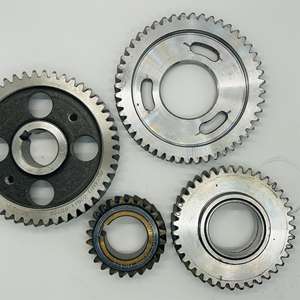A gear hobbing equipment is a specialized device made use of in the manufacturing of gears, employing a procedure called hobbing to generate high-precision gears for numerous industrial applications. This method is extensively favored for its performance, accuracy, and flexibility in developing spur equipments, helical equipments, worm wheels, splines, and gears. The process includes a reducing tool called a hob, which is a cylindrical device with helical teeth that progressively removes material from a workpiece to develop equipment teeth. Recognizing the auto mechanics of equipment hobbing requires an analysis of the maker’s components, the kinematics of the process, and the specifications influencing gear top quality.
(how gear hobbing machine works)
The equipment hobbing equipment includes numerous crucial elements: the hob, work surface pin, drive electric motors, indexing device, and feed system. The hob, installed on a turning arbor, is the primary cutting device. Its teeth are gashed to develop reducing sides, and their helical alignment matches the preferred equipment type. For example, a helical hob is made use of for reducing helical equipments, while a straight hob is utilized for spur gears. The work surface, usually a gear blank made of steel, cast iron, or various other metals, is firmly clamped onto the work surface pin. The pin turns synchronously with the hob, guaranteeing precise angular positioning between the device and the gear space.
The hobbing process operates on the principle of generating movement, where the hob and workpiece revolve in a timed connection. As the hob turns at a specific rate, the work surface pin turns proportionally to the hob’s rotational speed, controlled by the ratio of the number of hob strings to the number of gear teeth being reduced. This synchronized rotation guarantees that each hob tooth breakthroughs incrementally to cut succeeding equipment teeth. At the same time, the hob is fed radially or axially right into the workpiece to accomplish the needed depth and account. For helical gears, an added differential activity is introduced to line up the hob’s helix angle with the gear’s helix angle.
The indexing mechanism plays a vital role in preserving the angular connection between the hob and the workpiece. Modern equipment hobbing devices utilize CNC systems to automate indexing, feed prices, and rotational rates, enhancing accuracy and repeatability. The feed system manages the hob’s activity about the work surface, either alongside the equipment axis (axial feed) or vertical to it (radial feed). Axial feed is frequently made use of for spur and helical equipments, while radial feed is preferred for worm wheels and tapered gears.
Secret criteria affecting gear high quality include hob geometry, reducing rate, feed rate, and lubrication. The hob should be made with exact tooth profiles to guarantee exact equipment tooth geometry. Cutting speed, established by the hob’s rotational speed, influences surface area finish and tool life. Higher rates minimize cycle times yet might increase device wear. Feed rate controls product removal price; extreme feed can trigger tool deflection and inadequate surface area finish, while insufficient feed lowers productivity. Lubrication is crucial to dissipate heat, minimize rubbing, and evacuate chips, making certain smooth cutting and extending tool life.
Gear hobbing deals benefits over other gear-cutting techniques like shaping or milling. It is a continuous procedure, enabling higher manufacturing rates and far better surface area coatings. The capability to cut numerous teeth at the same time decreases cycle times, making it excellent for mass production. Additionally, the exact same hob can generate equipments of differing tooth counts within a details module range, boosting convenience. Nevertheless, the procedure calls for precise arrangement and alignment to avoid mistakes such as tooth spacing mistakes or profile deviations.
(how gear hobbing machine works)
Finally, equipment hobbing equipments are essential on duty production, integrating mechanical precision with sophisticated control systems to produce top quality equipments. By synchronizing rotational and feed activities, these devices achieve exact tooth profiles and reliable product elimination. As markets require gears with tighter resistances and complicated geometries, advancements in CNC innovation and tooling products remain to fine-tune the hobbing process, guaranteeing its importance in contemporary production.


